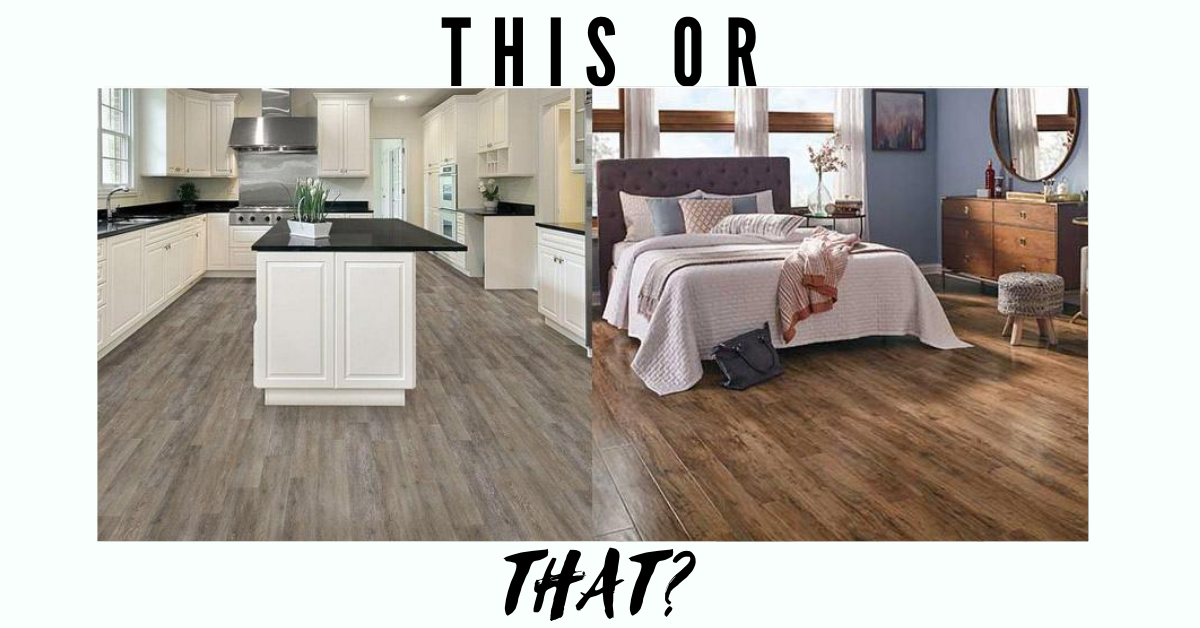When you want a durable, economical, attractive floor covering for your home that you can install by yourself, you may find yourself gravitating toward either vinyl flooring or laminate flooring. Both floors hit those key points. But between the two, which flooring is a better choice for your home?
Laminate VS Vinyl
Vinyl flooring is a 100-percent synthetic material. In standard sheet vinyl and vinyl tiles, the base layer is usually fiberglass which is then coated in PVC vinyl and a plasticizer. The resulting sheet is printed and embossed with a surface print layer. Over this, multiple wear layers are applied, along with a layer of no-wax polyurethane. With vinyl plank flooring, the core layer is a thicker, multi-layer PVC vinyl. Luxury vinyl flooring comes in planks or tiles that fit side-to-side to form a floating floor. The overall thickness for vinyl flooring ranges from 1.5 mm for sheet vinyl to 5 mm for luxury vinyl planks.
Vinyl flooring is made from 100 percent plastic. This composition gives it superior resistance to moisture. When water sits on vinyl floors, even for extended periods of time, it won’t damage the surface. Vinyl’s water resistance makes it an excellent choice for rooms that are prone to moisture. For example, kitchens, bathrooms and laundry rooms.

What’s the COST?
There is a wide range of costs for both laminate and vinyl flooring. For laminates, this cost range is determined by the thickness or number of layers in the material, the color (some darker colors cost more) and whether you are using a premium or basic material. Costs range from $1-5 per square foot for material and from $2-8 per square foot installed.
Vinyl also has a wide range of costs because there are so many different types on the market. Overall, there is also a typical range of around $1-5 per square foot for most vinyl flooring. Installed costs range from $1.75-7 per square foot, making both materials fairly comparable in cost, with vinyl being slightly cheaper.
Pros
Historically, many people considered vinyl aesthetically inferior to laminate. Now, however, vinyl has come a long way when it comes to style choices. You can find vinyl flooring that mimics the look and feel of stone, tile, and even wood floors with realistic accuracy.
One of the major benefits of choosing laminate flooring in the vinyl vs laminate debate is the comfortable feel underfoot. You may not think of this feature as a significant factor in your decision about which flooring type to choose, but the underfoot feel can have a big impact on whether you enjoy walking on your floors day in and day out. Laminate has a thicker composition that includes wood content, which helps it to feel warmer and slightly soft. Vinyl, however, tends to be quite hard and cold to the touch, so it’s generally not the best choice for main living areas and bedrooms.
Some types of vinyl flooring are waterproof. For example, wood plastic and polymer composite (WPC) vinyl is waterproof. This is thanks to its composition of thermoplastics, wood flour, and calcium carbonate. It can be installed in areas where high moisture levels are present. Other waterproof vinyl floor options include stone plastic composite (SPC) vinyl, made from natural limestone powder, polyvinyl chloride, and stabilizer. It is also known as rigid core vinyl. You can install it over many types of flooring as a floating floor. When considering moisture exposure, in the vinyl vs laminate debate, vinyl flooring is a clear winner.
Many homeowners prefer the look of laminate to that of vinyl. Although both flooring types come in a range of styles, colors, and patterns, laminate typically features better imagery or embossing that gives the floors a more realistic look. Generally, homeowners will choose laminate over vinyl for highly visible areas of their homes, such as entryways, living rooms, and dining rooms.

CONS
Vinyl has a longer lifespan and better overall durability than laminate. Don’t forget to factor in your budget, however. Vinyl flooring may be more expensive than laminate flooring, especially if you choose luxury vinyl flooring. Laminate flooring doesn’t last as long as vinyl and in many cases, laminate floors need to be replaced within 10 years of installation. The upside is that the initial cost of laminate floors is sometimes lower. If you’re on a tight budget, laminate flooring allows you to give your floors a fresh new look for less money. Be sure to save up for the eventual replacement floors if you plan to stay in your home for a long time.
Laminate is a synthetic product that simulates the look of real hardwood. It can have an authentic wood floor appearance that makes it popular with homeowners who like the style of hardwood but want to spend less money on flooring. Although it is a budget-friendly flooring type, laminate does not perform well when it comes to moisture.

In Summary…
So, who’s the winner in the laminate vs. vinyl flooring match? The real deal is this: There is no one-size fits all answer. Both are strong, beautiful floors that are less expensive than natural wood. The “better” option is mostly a matter of your opinion. Give each of these pros and cons some thought, visit your local flooring store to determine which one is most important to you.
Sources:
https://www.avalonflooring.com/ideas/blog/laminate-vs-vinyl
https://www.fixr.com/comparisons/vinyl-vs-laminate-flooring
https://www.thespruce.com/vinyl-vs-laminate-flooring-1822800

